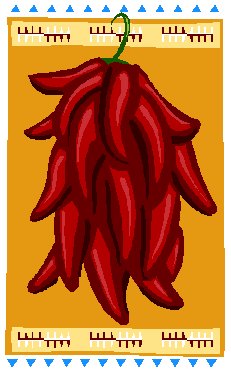 Growing Hot Chiles - June 3, 2009 Jeff Schalau, Associate Agent, Agriculture & Natural Resources University of Arizona Cooperative Extension, Yavapai County Chiles are thought to have originated in an area bordered by the mountains of Brazil, and Bolivia in South America. Over thousands of years chiles were spread by birds and native peoples to south and central America, Mexico and southwestern U.S. The ancient wild chiles had small, round, erect, bright red fruits that made them very attractive to birds, and birds are unable to feel the pungency associated with capsaicin. The seeds, however, are still viable after passing through a birdís digestive tract. The hotness of chiles is determined by the amount of capsaicin present. The heat scale most commonly used is measured in Scoville Units. Wilbur L. Scoville was a pharmacologist with Parke Davis: a drug company that used the compound capsaicin in its muscle salve called "Heet". The amount of capsaicin is still measured in Scoville Units (pure capsaicin equals 16,000,000 Scoville Units). Bell peppers have 0 Scoville Units. New Mexico chiles, such as NuMex Big Jim, Sandia, and New Mexico 6-4, range from 500-2,500 Scoville Units. These are the chiles roasted green and used in green chile. The ancestors of these chiles were first grown in the 1600's and were introduced to North America by Spanish explorers. New Mexico State University has developed many of the commercial varieties available today. These chiles turn red as they ripen and, when dried, are ground into chile powder or used to make ristras for storage. Pasilla chiles have dark brown pods and are sometimes called chile negro. Pasilla means "little raisin". These chiles range from 1,000-1,500 Scoville Units. Pasillas are thought to be the immediate predecessors of the New Mexico type. They are grown in Mexico and used to make mole sauces. Jalapeno chiles range from green to purple in color and range from 2,500-5,000 Scoville Units. They are used in fresh salsa, pickled and canned or bottled, and smoked to produce chipotle. Jalapenos have a unique balance of flavor and heat that make them popular in many mainstream American foods such as poppers and nachos. Serrano chiles are dark green and narrower than jalapenos. They often ripen to red, orange, or yellow and range from 10,000-23,000 Scoville Units. Serranos are popular in Mexico and gaining popularity in the United States. They are commonly used in fresh salsa. Chiltepin chiles are wild ancestors of today's commercial varieties. They start at 70,000 Scoville Units and go upward from there. They are small, round, red fruit that bear profusely. The Tarahumara Indians of Sonora believe that these chiles protect them from sorcerers. Habanero chiles have 200,000-300,000 Scoville Units. These are the hottest commercially available chiles in U.S. markets. It is of South American origin and seeds have been found in Peru that dated from 6500 B.C. Cultural practices are identical for both chiles and peppers. The garden space should receive at least eight hours of direct sun. In hot areas, the intense afternoon sun can burn the fruit. Ideal soils are well-drained, loamy and neutral to slightly basic (pH 7-7.5). Adding organic matter, such as aged manure or compost, to the soil is always a good practice for all garden crops. Clayey and sandy soils require greater amounts of organic matter. In addition, a moderate amount of nitrogen and phosphorus fertilizer will encourage vigorous plants and improve crop yields. You can find many common varieties for sale at nurseries and garden centers, but real aficionados grow their own transplants from seed. Early June is still an acceptable time for planting transplants in north central Arizona. To set fruit, chiles require daytime temperatures between 65 and 80 degrees F and night temperatures above 55 degrees F. Fruit will not set when night temperatures remain above 86 degree F. The best crops are usually produced in late summer and fall when it cools down. Proper irrigation is critical in chiles. Chiles can be irrigated either by flooding or drip system as long as the water is allowed to soak in deeply. The University of Arizona Cooperative Extension has publications and information on gardening and pest control. If you have other gardening questions, call the Master Gardener line in the Cottonwood office at 646-9113 ext. 14 or E-mail us at cottonwoodmg@yahoo.com and be sure to include your address and phone number. Find past Backyard Gardener columns or submit column ideas at the Backyard Gardener web site: http://cals.arizona.edu/yavapai/anr/hort/byg/. |